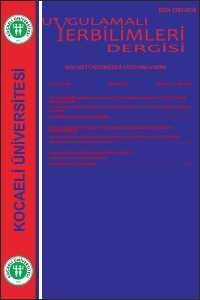Yapay Sinir Ağları Kullanılarak Karbonat Kayalarındaki Dokunun Tanınmasına Bir Örnek: Akveren Formasyonu
Mikroskopta incelenen karbonat kayalarda dokunun türünün belirlenmesi jeolojik araştırmalarda önemlidir. Petrol sondajlarında olduğu gibi kayaç örneklerinin hızlı bir şekilde değerlendirilmesi gereken durumlarda bu örneklerin tanımlanması görüntü işleme teknikleri ve yapay sinir ağları kullanılarak hızlı bir şekilde yapılabilir. Daha önceki bir çalışmada, bu yöntem kullanıldığı zaman kireçtaşı örneğinin, Dunham (1962) sınıflamasında çamurtaşı, vaketaşı, istiftaşı, tanetaşı olarak sınıflanan örneklerin yapay sinir ağları kullanılarak % 93 oranında dokunun doğru olarak belirlenebileceği yayınlanmıştır. Bu çalışmaise daha önce denenmiş yukarıdaki yöntemin İzmit ve çevresindeki Akveren formasyonu kayaç örneklerine uygulanmasıdır. Akveren formasyonundan alınan kayaç örneklerinden 45 adet ince kesit yapılmıştır. Bu ince kesitlerin fotoğrafları çekilerek bu görüntüler bilgisayarda MATLAB programında “Sobel” filtresi kullanılarak görüntü işleme çalışması ve sonra yapay sinir ağları kullanılarak yukarıdaki 4 sınıftan hangisine yerleşeceği konusu irdelenmiş ve mikroskopta belirlenen doku sınıflamasıyla karşılaştırılmıştır
Case Study for Identification of Texture in Carbonate Rocks Using Artificia Neural Networks: Akveren Formation
The determination of the texture in the carbonate rocks examined by microscope is important in the geological researches. Similar to oil drillings operations, quick determination of the rock samples is possible using image processing techniques and artificial neural networks. A previous study using this method when the limestone samples, in Dunham (1962) classification as mudstone, vackestone, packstone, grainstone of the sample by using artificial neural networks at a rate of 93% of the texture may be determined as accurately have been published. In this study, a similar method has been applied to the sample rocks known as Akveren formation located at İzmit and around. Using the samples from Akveren formation, 45 units with thin sections were made. The photos of thin cross-section were taken, then these pictures have been processed on the computer using MATLAB software. During the imageprocessing, "Sobel" filter was used. Then, by using artificial neural networks, the samples were examined in order to classify
___
- DUNHAM, R. J., 1962. Classification of Carbonate Rocks According to Depositional Texture. In Classification of Carbonate Rocks,W.E. Ham. (ed.), 108-121. Amer. Ass. Petrol. Geol. Mem. Tulsa,Oklahoma.
- ERGEZER, H., DİKMEN, M. ve ÖZDEMİR, E., 2003. Yapay sinir ağları ve tanıma sistemleri. PiVOLKA, 2(6), 14-17.
- ERTUNÇ, H. M., 2006. Prediction of the Pool Boiling Critical Heat Flux Using Artificial Neural Network, IEEE Transactions on Components and Packaging Technologies, Vol.29, No.4, p.770-777.
- ERTUNÇ, H. M., HOŞÖZ, M., 2008. Comparative analysis of an evaporative condenser using artificial neural network and adaptive neuro-fuzzy inference system, International Journal of Refrigeration, vol. 31, p.1426-1436.
- HAGAN, M.T., DEMUTH, H.B., BEALE, M., 1996. Neural Network Design, PWS Publishing Company, Boston, M.A.
- MARMO, R., AMODİO, S., TAGLİAFERRİ, R., FERRERİ, V., LONGO, G., 2005. Textural İdentification of Carbonate Rocks by İmage Processing and Neural Network: Methodology Proposal and Examples. Computers and Geosciences. pp. 649-659.
- ISSN: 1302-0218
- Başlangıç: 1996
- Yayıncı: Kocaeli Üniversitesi
Sayıdaki Diğer Makaleler
İstanbul'un Avrupa Yakasındaki Zemin ve Kaya Koşullarının Bina Temellerine Etkisi
Süleyman DALGIÇ, Mehmet TURGUT, İbrahim KUŞKU, Çağdaş COŞKUN, Turgay COŞGUN
ÇAYIRHAN İLÇESİ’NİN, ANKARA, ZEMİN ÖZELLİKLERİNİN JEOFİZİK VE GEOTEKNİK YÖNTEMLERLE ARAŞTIRILMASI
Kocaeli'de Yer Alan Killi Zeminlerin Zemin-Su ve Kayma Dayanımı Özellikleri
Cengiz KURTULUŞ, Maral ÜÇKARDEŞ, Ahmet YOĞURTÇUOĞLU
Jeofizik ve Geoteknik Metotlarla Mühendislik Uygulamaları: Yalova'da Arazi Uygulaması
